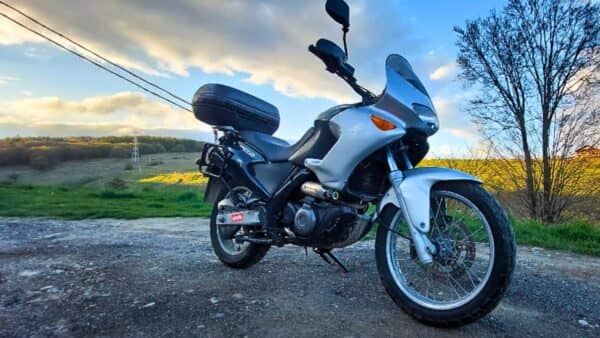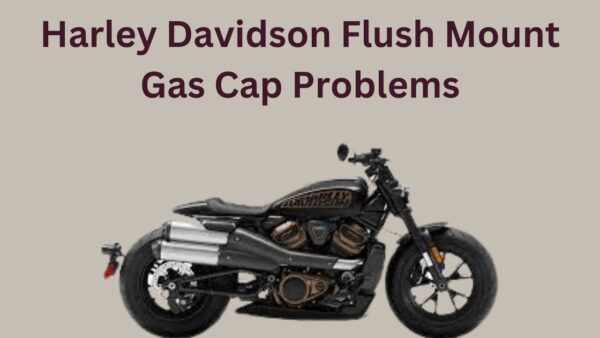The Aprilia Pegaso 650 is a well-regarded motorcycle known for its versatility and robust performance.

However, like any other vehicle, it’s not immune to issues. Owners may face a variety of problems related to engine performance, electrical systems, or structural components.
In this post, we will discuss the common problems that Aprilia Pegaso 650 owners have encountered and offer practical solutions.
Let’s dive in!
Aprilia Pegaso 650 Problems
Aprilia Pegaso 650 common problems are the engine stopping suddenly, brake discs contact with brake pads, stalling, difficulty starting in cold weather, and sometimes not starting.
1. Engine Stopping Suddenly
One of the issues that Aprilia Pegaso 650 users have reported is the sudden stopping of the engine, often accompanied by a loud clinking noise.
Based on user feedback, there are two probable culprits behind this problem: the connecting rod (conrod) bearing or the sprag clutch.
The con rod bearing forms an essential link between the piston and the crankshaft. If it fails, it may lead to the abrupt stopping of the engine.
The loud clinking noise that some users have reported could be due to metal-on-metal contact, which occurs when the bearing wears out.
In such a scenario, you’ll need to replace the damaged bearing to restore the engine’s functionality.
On the other hand, the sprag clutch enables the engine to turn the starter motor without the starter motor turning the engine.
However, if the sprag clutch malfunctions, it can result in sudden engine failure.
A faulty sprag clutch might not disengage properly after the engine starts, which causes the engine to stop abruptly.
To resolve this problem you should thoroughly check both the con rod bearing and sprag clutch. If the con rod bearing is worn out, replace it with a new one.
If the sprag clutch is not disengaging properly, it may be due to wear and tear, and replacing it could resolve the sudden engine stoppage.
2. Brake Discs Always in Contact with Brake Pads
Some owners also have encountered the issues of brake discs continually being in contact with the brake pads.
This problem often arises due to the sticking of the calliper piston. The calliper piston is a crucial component of your braking system.
When you apply pressure to the brakes, the hydraulic fluid pushes the piston against the brake pads, which then press against the brake disc to halt the bike.
If your brake discs are always in contact with the brake pads, it can lead to several issues.
Firstly, it can result in excessive wear on both the brake pads and the discs, reducing their lifespan and necessitating frequent replacements.
Secondly, the constant friction can generate heat, which may warp the brake discs.
Lastly, this issue can lead to reduced fuel efficiency as the bike has to work harder to overcome the continuous braking effect.
In this situation, you should ensure that no debris or dirt is causing the piston to stick. Clean the area thoroughly with a specialized brake cleaner.
If the issue persists, it might be due to corrosion of the piston or a fault with the brake fluid.
You can try to lubricate the piston with brake fluid, or if corrosion is apparent, it may need to be replaced.
If all else fails, replacing the brake calliper assembly might be the last resort.
3. Stalling When Slowing Down
This problem tends to be more prevalent when the bike is cold and can be bothersome and unsafe.
This stalling issue can be attributed to a few different factors. The most likely cause is a problem with the fuel or ignition system.
When the bike is cold, the air-fuel mixture in the carburettor can become too dense for the spark plugs to ignite effectively, which leads to the engine stalling.
A faulty idle air control valve could also be the root of the problem. If it’s malfunctioning, it could cause the engine to stall out when slowing down.
So, you should check the spark plugs and replace them if necessary. Then clean the carburetor, it can also help rectify the dense air-fuel mixture problem.
Lastly, inspect the idle air control valve for any signs of malfunction and consider replacing it if it appears to be the issue.
4. Difficulty Starting in Cold Weather
A few owners have reported issues with starting the bike in colder temperatures, a common phenomenon that requires an understanding of the causes and potential solutions.
Bikes, like other internal combustion engines, can struggle in cold weather because the low temperatures affect the chemical reactions that make the engine run.
Firstly, the cold affects the battery. Battery performance drops in low temperatures, which reduces its ability to provide the necessary power to start the engine.
The thicker oil due to the cold can also make it more difficult for the engine parts to move as swiftly as they need to.
The fuel-air mixture in the bike’s carburettor could also be affected by the cold. For combustion to occur, the ratio of fuel to air has to be just right.
One solution can be to store your bike in a warmer place if possible, to reduce the effects of the cold on the battery and oil.
If changes in the fuel-air mixture due to cold weather are the issue, adjusting the choke to allow a richer mix of fuel might help.
You can also invest in a stronger battery or use a block heater, a device that warms the engine and helps it start in cold weather.
5. Engine Overheating
While the machine is built to withstand high temperatures, significant heat can still cause damage, and there are several reasons for this.
Firstly, a low coolant level in the radiator can contribute to overheating. The coolant helps in dissipating the heat produced in the engine.
If it’s not at the appropriate level, the engine might overheat due to inadequate cooling.
This could be due to leaks in the radiator or hoses, or it might just be that the coolant hasn’t been topped up or changed in a while.
Secondly, the thermostat controls the coolant flow, so if it is not opening correctly, it might not be allowing the coolant to flow through the engine, causing it to overheat.
Lastly, if the radiator gets clogged with debris and dirt, it can restrict the flow of the coolant, thereby not allowing the heat to be dissipated correctly.
So, you should regularly monitor the coolant level and ensure it’s always at the recommended level.
If the thermostat is at fault, you should replace it with a new one. For a blocked radiator, a coolant flush could help remove the debris.
6. Clutch Problems
A common issue can be the clutch feeling ‘sluggish’ or ‘heavy’. This means that the clutch does not engage or disengage as smoothly as it should.
It could be due to worn-out clutch plates or a problem with the clutch cable.
Worn-out clutch plates can cause the clutch to slip, meaning the engine revs increase but the bike doesn’t move as it should.
This is usually a sign that the friction material on the plates has worn thin and needs to be replaced.
Sometimes, the clutch cable could be at fault. If it’s too tight, it can make the clutch feel heavy and hard to pull.
On the other hand, if it’s too loose, the clutch may not fully disengage when you pull the lever. Adjusting the tension of the clutch cable can solve this problem.
Another possible reason could be a weak or broken spring can prevent the clutch from disengaging properly, leading to a spongy feel in the lever.
In the case of hydraulic clutch systems, leaking clutch fluid or air bubbles in the hydraulic line can cause problems.
This is often characterized by a soft clutch lever and poor disengagement.
To rectify this, you can try bleeding the clutch system to remove any air bubbles and ensure the hydraulic fluid is at the correct level.
Aprilia Pegaso 650 Technical Specifications
| Specification Category | Details |
| General Information | |
| Model Name | Aprilia Pegaso 650 |
| Year of Manufacture | 2000 |
| Type | Enduro / Offroad |
| Engine and Transmission | |
| Engine Size | 652.0 ccm (39.79 cubic inches) |
| Engine Type | Single cylinder, four-stroke |
| Output | 50.0 HP (36.5 kW) |
| Torque | 54.0 Nm (5.5 kgf-m or 39.8 ft.lbs) |
| Gearbox | 5-speed |
| Chassis, Suspension, Brakes and Wheels | |
| Front Brakes | Single disc |
| Physical Measures and Capacities | |
| Dry Weight | 180.0 kg (396.8 pounds) |
| Power/Weight Ratio | 0.2778 HP/kg |
| Seat Height | 870 mm (34.3 inches) – If adjustable, lowest setting |
Aprilia Pegaso 650 Customers Review
The Aprilia Pegaso 650, produced from 1997 to 2009, is a stylish sports touring motorcycle that combines supermoto elements with trail bike features.
It offers easy handling, a comfortable seating position, and excellent brakes. While it’s not suitable for off-roading, it performs well on highways and back roads.
The bike’s fuel injection can be a bit jerky in urban settings, but overall, it has good build quality and reliability, thanks to its robust Yamaha engine.
The Aprilia Pegaso 650 is a great choice for beginners and smaller riders seeking an enjoyable and affordable ride.
You can also check out the problems with Aprilia Shiver 750, Aprilia Shiver 900, Aprilia Tuono V4, Tuareg 660, Scarabeo 500 & Scarabeo 200
Source: Aprilia | Aprilia Pegaso 650 Review

Ahtsham Younas is a passionate blogger and content writer. He loves to ride motorcycles and learn the mechanical process behind the motorcycles.
He has been writing articles in the motorcycle industry since 2019 and has learned many things about motorbike niches.


